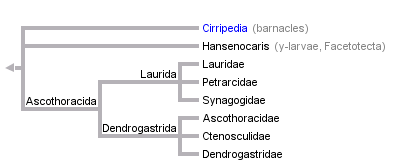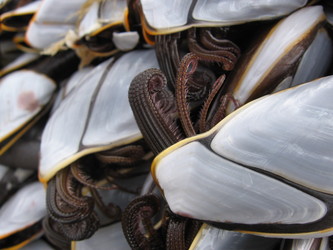Thecostraca
Barnacles and their relatives



This tree diagram shows the relationships between several groups of organisms.
The root of the current tree connects the organisms featured in this tree to their containing group and the rest of the Tree of Life. The basal branching point in the tree represents the ancestor of the other groups in the tree. This ancestor diversified over time into several descendent subgroups, which are represented as internal nodes and terminal taxa to the right.

You can click on the root to travel down the Tree of Life all the way to the root of all Life, and you can click on the names of descendent subgroups to travel up the Tree of Life all the way to individual species.
For more information on ToL tree formatting, please see Interpreting the Tree or Classification. To learn more about phylogenetic trees, please visit our Phylogenetic Biology pages.
close boxReferences
Grygier, M. J. 1987. Classification of the Ascothoracida (Crustacea). Proceedings of the Biological Society of Washington 100:452-458.
Grygier, M. J. 1987. Reappraisal of sex determination in the Ascothoracida. Crustaceana 52:149-162.
Grygier, M. J. 1987. Nauplii, antennular ontogeny, and the position of the Ascothoracida within the Maxillopoda. Journal of Crustacean Biology 7:87-104.
Grygier, M. J. 1987. New records, external and internal anatomy, and systematic position of Hansens Y larvae Crustacea. - Maxillopoda: Facetotecta. Sarsia 72:261-278.
Grygier, M. J. 1996. Classe des Thécostracés (Thecostraca Gruvel, 1905). Sous Classe des Facetotecta (Facetotecta Grygier, 1985). Pages 425-432 in Traité de Zoologie, Vol. 7 (2), Crustacés: Géneralités (suite) et systématique (1re partie). Forest, J., ed. Masson, Paris.
Høeg, J. T. and G. A. Kolbasov. 2002. Lattice organs in y-cyprids of the Facetotecta and their significance in the phylogeny of the Crustacea Thecostraca. Acta Zoologica 83:67-79.
Martin, J. W. and G. E. Davis. 2001. An updated Classification of the Recent Crustacea. Natural History Museum of Los Angeles County Science Series 39. Los Angeles, CA.
Pérez-Losada, M., J. T. Høeg, G. A. Kolbasov, and K. A. Crandall. 2002. Reanalysis of the relationships among the Cirripedia and the Ascothoracida and the phylogenetic position of the Facetotecta (Maxillopoda: Thecostraca) using 18S rDNA sequences. Journal of Crustacean Biology 22:661-669.
Spears, T., L. G. Abele, and M. A. Applegate. 1994. Phylogenetic study of cirripedes and selected relatives (Thecostraca) basedon 18S rDNA sequence analysis. Journal of Crustacean Biology 14:641-656.
Title Illustrations

| Scientific Name | Lepas anatifera |
|---|---|
| Location | causeway between Worm's Head and the Gower mainland, Wales |
| Specimen Condition | Live Specimen |
| Source | things (goose barnacles) close up |
| Source Collection | Flickr |
| Image Use |
 This media file is licensed under the Creative Commons Attribution-NonCommercial License - Version 2.0. This media file is licensed under the Creative Commons Attribution-NonCommercial License - Version 2.0.
|
| Copyright | © 2007 pshab |
| Scientific Name | Synagoga sp. (probably undescribed) on Antipathella |
|---|---|
| Location | Azores |
| Comments | One of the rare free-living genera in this group (the others are endoparasites). |
| Specimen Condition | Live Specimen |
| Identified By | William Newman |
| Copyright |
© Peter Wirtz

|
About This Page
Page copyright © 2002
All Rights Reserved.
Citing this page:
Tree of Life Web Project. 2002. Thecostraca. Barnacles and their relatives. Version 01 January 2002 (temporary). http://tolweb.org/Thecostraca/6251/2002.01.01 in The Tree of Life Web Project, http://tolweb.org/









 Go to quick links
Go to quick search
Go to navigation for this section of the ToL site
Go to detailed links for the ToL site
Go to quick links
Go to quick search
Go to navigation for this section of the ToL site
Go to detailed links for the ToL site